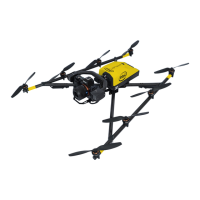USER MANUAL
INTEL® FALCON™ 8+ UAS
© 2018 Intel Corporation. All rights reserved 79
Charging
• Before charging, visually inspect the battery. Look for any damaged connectors
or other irregularities. Do not use it if you find any of the above issues with your
battery.
• If any damage to the battery is found or if the voltage is significantly less for your
battery than what is specified below, do not attempt to charge or fly with the
battery; contact your supplier.
• Never charge batteries unattended.
• Charge in an isolated area, away from flammable materials. Use deliverable
LiPo-safe bags or a non-flammable case for charging.
• Let the battery cool down to ambient temperature before charging.
• You may witness a battery starting to balloon or swell up. This may lead to a
deformed housing where the battery no longer fits into the UAV battery
compartment. If you notice such a deformation, do not start charging this
battery. If you already started charging, discontinue the charging process
immediately. Disconnect the battery and observe it in a safe place for an
appropriate period. Continuing to charge a battery that has begun to swell will
result in fire. Never use a battery if you find it swollen or ballooned.
Discharging
Do not discharge a battery to a level below 3.5 V per cell. Deep discharging a battery
cell below 3.5 V can reduce battery performance or even destroy the battery.
Storage & Transportation
New batteries are delivered with less than 30% charge, to comply with regulations
which allow Li-Po batteries to ship via air. Because the battery slowly self-discharges, it
is important to maintain battery charge state, and periodically check batteries charge
level to avoid deep discharge. Therefore, Intel recommends charging batteries
periodically when in storage according to the instructions provided in this chapter.
The Intel® Powerpack Battery has an internal Battery Management System (BMS) which
must use the battery power to use the charging circuit. If the battery’s power level is
allowed to drain to a “zero state”, the battery will not be able to recharge due to safety
limits that prevent charging a deeply-discharged battery, which is not recommended.
However, storing a fully charged battery has negative effects on its life span.
Battery Storage/Charging Maintenance Recommendation
• Intel recommends to charge/recharge batteries to a level between 2 and 4 LED’s
(40-80%) every 3 months to maintain optimal cell performance and reliability.
• If a battery is charged to 100% (5 LED’s), but needs to be stored, it can be put
back into safe voltage level by activating Battery Storage Mode. (see Operating
The BMS Menu, “Menu Option 2, Storage Mode” on page 74).
• Only completely charge batteries immediately before the next flight.

